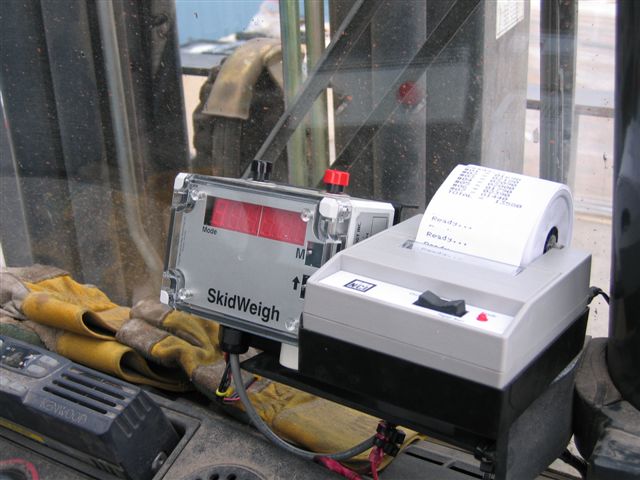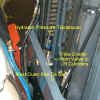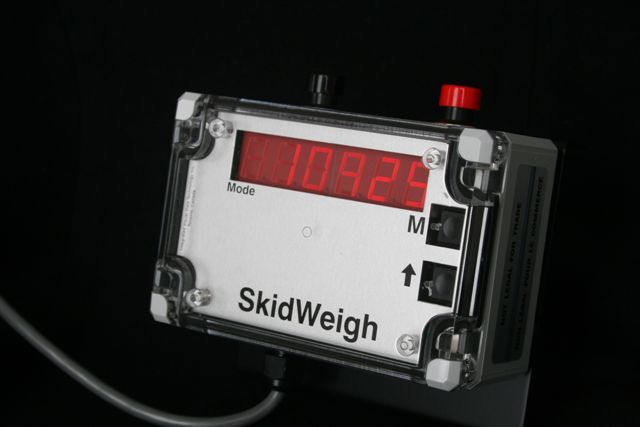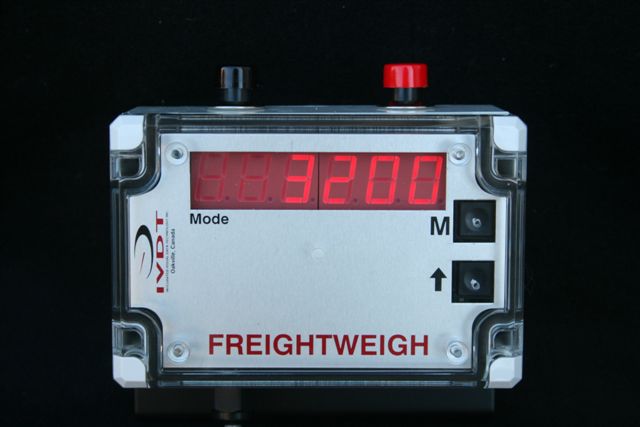|
Responding to the lift
truck industry's request for a simple and economical lift truck
on-board check weighing system that can be used in any material
handling operation and will operate in severe working environment;
we have developed the ED2-Series SkidWeigh.

Material handling fleets which have a variety
of lift trucks can now standardize and utilize a single check
weighing system on all of their vehicles. The ED-Series can
be used as a direct replacement for earlier versions of the
TC, SM and the SLL Series of the SkidWeigh check weighing systems.
The most popular application of this system is
the freight weight verification of shipping pallets in the transportation
industry. The transportation loading dock lift trucks equipped
with the SkidWeigh will recoup the underestimated freight weight
revenue that otherwise will slip through the system unnoticed.
The
ED2-Series SkidWeigh systems are the only lift truck on-board check weighing systems that
are found
to
be installed and used in multiple quantities (10, 25, 50 and more
units) within the same operational facilities, worldwide.
|
|
- Low installed cost
- Virtually maintenance free
- No operator training required
- Can be moved from one vehicle
to another
- Will not reduce lift truck lift
capacity
- Can be installed by a local
lift truck service technician or the end user mechanic
- Resistant to industrial
environments
- Field serviceable
- Wide range, check weighing
capacity up to 50000 kg or lbs.
- Operating temperature ranging
from -40°C to +85°C (-40 to +185° F)
- Accurate to +/- .5 to 1% of
vehicle lifting capacity
|
The ED2-Series will provide the operator's with the visual
tool indicating the current load weight status at any time.
This vital piece of the information can prevent
the vehicle tipping and possible injuries to the lift truck
operator and damages to the vehicle and goods being handled.
In addition to the safety aspect, vehicle
stability and avoidance of damages to the truck,
stacking warehouse racks and shelving with allowed maximum load weight
becomes much easier. The installed unit will assure
that the truck can do the work you need done, by eliminating the costly
damages to the warehousing storage equipment.
 

click
on image to enlarge 
Weighing
and Research Programs for Trucking Companies Prove to be Practical,
Profitable and Good Public Relationship

Click
on NMFTA logo above to go to Classification, Weighing and Research
website
Reprinted
from National Freight Traffic Association
Trucking companies establish weighing and
research programs to verify that shipment weights, commodity description
and densities of shipments are accurate. This ensures that all shippers
are treated equally, with like commodities moving at the same classes.
The little-known benefit ( that is to carriers that have yet to
establish W&R programs) is that they are a wise business investment.
W&R
programs are responsible for recovering additional revenue of about
one percent of gross revenue. Companies with established W&R programs
recover an even greater percentage. In fact, establishing and supporting
W&R programs, motor carriers have reduced their operating
ratio by a full percentage point. In the course of doing business
it makes sense to verify information provided to you by your customers.
In fact, carriers have more than a business incentive to ensure that
freight is properly classified, they also have a legal incentive.
The law states that no common carrier shall
charge or collect or receive a greater or less or different compensation
than the rates and charges specified in the tariffs at the time (49
USC £ 10761 (a). So, when you refer to the National Motor freight
Classification (NMFC) in your tariffs as the governing publication,
the involved shipments must comply with its provisions. That is to
say, if a shipment of ping pong balls, (named in item 15580 and assigned
a class 500) is listed on the bill of lading as a shipment of composition
or plastic billiard or pool balls per item 15700 at class 85,
it is the carrier's responsibility to correct the shipping papers
and to reclassify the shipment accordingly.
Active weighing and research programs do
more than just verify the description and weights of shipments, they
also provide equity for carrier customers and inform and educate carrier
staff and shippers. The correct assessment of freight charges guarantees
that each shipper will bear its fair share, and only its fair share
of the total transportation burden. This eliminates the potential
for discrimination and unfair competitive advantage.
Further, most shippers do not have the
resources to employ the necessary qualified personnel needed to correctly
interpret a rate tariff, nor do they maintain tariff libraries. Even
large firms with extensive traffic department could not be expected
to keep pace and weights are often honest mistakes made by uninformed
shipping clerks, not intentional misclassifications.
The law requires the correct assessment
of freight charges, and all responsible companies recognize that fact.
In most instances, the educational process or a competent W&R
program will quickly correct erroneous descriptions and weights to
the benefit of all. Also, a weighing and research program educates
carrier and shipper personnel about how to use and understand a modern
rate tariff.
Through a weighing and research program,
carriers can take the time to explain to their customers why freight
should be described appropriately, they can lessen the impact of a
description change that may result in a higher charge, and they have
a capable group of well-informed employees able to quickly answer
shipper questions. For these
reasons, W&R has proven to be a valuable public relations tool.
As
an added bonus, during the calendar year 1997, member carriers who
reported their increased revenue derived over 100 million dollars
from their weighing and research programs. The approximate the additional
revenue that your company may expect to recover through such a program,
consider the following:
The
experience of carriers who currently have programs indicates that
grossing 25 million dollars may expect to recover about a quarter
of a million dollars that would otherwise be lost. As to the
cost to this activity, the average operating ratio is 20. This means
that 4 of every 5 dollars received is a pure profit. Without a Weighing
and Research program, a 25 million dollar company, with an operating
ratio of 95 would have to generate 5 million dollars in additional
revenue to earn an additional quarter of a million dollars in operating
income. Have your financial manager figure your share and carry
the appropriate amount to the bottom line to see how a W&R program
would affect your company's net profit.
For
information on how to start your own Weighing and Research Program,
please call Dan Horning at 703 838-1820
Application
- Manufacturing
- Distribution
- Warehousing
- LTL Freight Trucking
- Motor Vehicle Parts
Manufacturing
- Pulp and Paper
- Rubber and Plastics
- Forging and Stamping
- Recycling
- Shipping and Receiving
- Agriculture
- Cement plants
- Breweries
- Stamping
- Mining
- Printing
- Food Processing

 


 






Technical Data
Electrical :
Voltage 12 to 55V DC
Current: LED Version, Operating 25mA maximum
Physical :
120 mm x 80 mm x 55 mm
Technology :
Micro Controller
Display :
LED display, six digits
Resolution 5 counts standard
Data Update Rate : approx. once per second
Pressure Transducer :
Standard pressure port connection: 1/4"-18 NPT , male thread standard
Optional pressure port : M 12x 1,5
Accuracy: +/- 0.3% of full scale
Repeatability: +/- 0.05% of full scale
Hysteresis: +/- 0.1% of full scale
Stability: +/- 0.2% full scale/yr
Temperature Information :
Compensation: 32° F to 175° F
Drift: +/- 0.03% /50 ° F
Medium: -22° F to 212° F
Ambient: 14° F to 175° F
Storage: -40° F to 212° F
Materials of Construction :
Casing: Stainless steel 1.4305 (AISI 303)
Weight : 95 grams
Shock Sensitivity : <+/- 0.05%
full scale @ 100g for 20 ms
Vibration Sensitivity : <+/-
0.05% full scale @ 35g & 5-2000Hz
Response Time : < 0.1 ms,
10-90% FS
Frequency Limit : 150 Hz
Proof Pressure :
2,5 x range
Burst Pressure : 2,5 x
range
Output : 3 wires 0 - 2,5 V DC
Protection : Environmental:
IP67
Fault Protection:
Reverse polarity
Over voltage
Short circuit

 Swiss Made Pressure Sensors
Swiss Made Pressure Sensors
Standard
outside thread 1/4"-18 NPT male thread with pressure
tip orifice
| Interference
Stability |
Test
Standard |
Effects |
| Electrostatic discharge (ESD) |
EN 61000-4-2
15 kV air discharge, 6kV contact discharge |
No effect |
| High- frequency electromagnetic radiation (HF) |
EN 61000-4-6
200mV, 80....1000Mz |
No effect |
| Conducted HF interferences |
EN 61000-4-6
30V. 0,15...80 Mhz |
No effect |
| Fast transients (burst) |
EN 61000-4-4
4kV |
No effect |
| Surge |
EN-6100-4-5
Line-Line, Line-Case 500V, 12Ohm, 9µF |
No failure |
| Magnetic fields |
EN 6100-4-8
30A/m, 50 Hz |
No effects |
| Insulation voltage |
500 VDC ( optional 1000 VDC ) |
No effect |
| Interference emit |
Test standard |
Effects |
| Conducted interference Radiation from housing |
EN 55022
0,15... 30Mhz
30... 1000Mhz, 10 meters |
No emis |
System Check Weighing Accuracy : +/- 0.5 to 1%
of the vehicle lifting capacity


OEM
SkidWeigh System
Hydraulic
Pressure Transducer OEM Check Weighing System
Design concept of the ED-Series allows the OEM's
to offer this product as a standard or optional equipment with the vehicles in their product line, regardless
of the vehicle operating voltage, vehicle lifting capacity or
vehicle type or model.
Factory installed system can be easily calibrated at the dealer's
or end user's location once the vehicle is ready for delivery
to the customer with the specified forks or
attachment installed. With the OEM's provision for the pressure transducer
port outlet in the hydraulic lift circuit, the ED2-Series can be fitted
into the vehicle in less than an hour at the forklift dealer
facility.


Compact size, Length
120 mm x Height 80 mm x Depth 55 mm
Patented Technology USA 4,757,712; 4,949,263 Canada
1302566; 1304479 Australia 598,376;605,647 Germany 38811280.0; 3887754.6
EC 0293697; 0351453
Integrated
Visual Data Technology Inc. Oakville, Ontario, Canada |